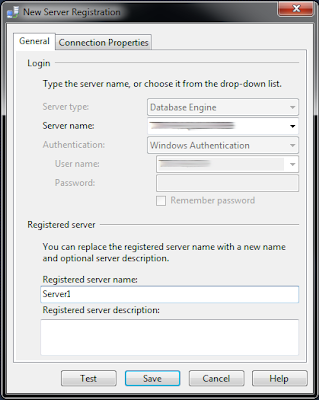As a database administrator, you
may be in charge of multiple databases.
But often times, it’s the multi-server/instance burden that becomes the
most “click” intensive. What I mean by
that is you have to connect to multiple servers and multiple instances, or in
SSMS connect your Object Explorer to a bunch of different instances, and before
you know it you have a spaghetti cluster of instances on your desktop. You end up spending 90% of the time just
mis-clicking the wrong one, or worse, executing T-SQL against an unintended
instance.
Sometimes, the above scenario is
necessary. But for much
object/database/instance/server administration, this can be carried out with
PBM (Policy-Based Management) with the combination of CMS (Central Management
Servers). This central location allows
for the convenient method for do many tasks, and this blog post will focus on
PBM with CMS.
Policy-Based Management in and
of itself is a great addition with SQL Server 2008. But when you have dozens (or even hundreds)
of instances that require a standard set of policies and conditions, manually
pushing them out and evaluating them would be absurd (and let’s be honest…we
should be automating at every possible junction).
The first step to utilizing PBM
with CMS is registering a Central Management Server: Through SSMS in the Registered Servers
section, right-click on Central
Management Servers and select Register
Central Management Server…. Select a
SQL Server 2008 or higher instance to act as the CMS:
To logically group your servers,
I recommend creating a Server Group: Right-click on the CMS and select New Server Group…. Name the Server Group to your desire. I will be calling mine “2008R2” as this
Server Group will house my 2008 R2 instances, and “2012” to contain my 2012
instances:
Now I want to register a server
in my 2008R2 Server Group:
My Registered Servers pane
should look like the below now. Mind
you, there are only a couple of instances here and this is a very over-simplified implementation of
CMS:
There are a couple of ways to
approach PBM with CMS: 1) Create a
Policy on the Central Management Server and use that to evaluate against
managed servers, or 2) create a Policy and export/import to the managed servers. I will be focusing on the former method.
Go to the CMS and create a
Policy. Because this is not an in-depth
look at the extreme flexibility and power of PBM, I will just use an MS-shipped
out-of-the-box Best Practices Policy to import as an XML file. In the Object Explorer of my CMS I will go
into Management, Policy Management. Right-click on Policies and select Import
Policy…. Navigate to the desired
Policy File (XML file format) and select it.
I chose the famous Database Auto Close Policy to work with:
Now that I have a Policy created
on my CMS, so I will not worry about duplicating this effort and
exporting/importing into my registered servers.
Back at the Registered Servers SSMS pane, I want to be able to evaluate
this Policy against all of the servers registered under my CMS named
“CMS”. I simply right-click on the CMS
and select Evaluate Policies…. Now I will need to select the source. In this case, my CMS will house all of the
Policies, so I’ll choose this server.
Select the Policy(ies) that you want to evaluate against the registered
servers, and click Evaluate. You should be staring at your evaluation
results for the registered servers in the scope of where you selected to
evaluate policies:
And there it is! We have just used the administrative power of
Policy-Based Management, and ease of Central Management Servers to evaluate a
Policy against a subset of registered servers.
If there are any comments, questions, or issues please feel free to
leave a comment or email me at sqlsalt@gmail.com.







No comments:
Post a Comment